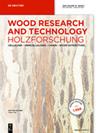Clarifying the decay process by Inonotus obliquus in Japanese white birch naturally grown in Nikko, Japan
IF 1.6
3区 农林科学
Q2 FORESTRY
引用次数: 0
Abstract
Abstract Decay process of wood of Japanese white birch [Betula platyphylla Sukaczev var. japonica (Miq.) H. Hara] tree by Inonotus obliquus (Fr.) Pilát was clarified by using the regression model in wood color and chemical components as a function of height position (1, 2, 3, and 4 m above the ground), wood type (sound wood and decayed wood), and their interactions, and anatomical observations. The 3 m height position, at which a sclerotium of I. obliquus was found, showed the highest decayed area percentage among four height positions. By the results of two-way analysis of variance, wood type affected all color indice. In addition, all factors (height position, wood type, and their interaction) were significant in all wood chemical components except for Klason lignin and hemicellulose. In the wood of the reaction zone, some substances were formed in the lumens of many vessels and a few wood fibers. Based on the results, we proposed the decay process of I. obliquus in naturally grown Japanese white birch, and the proposed process will contribute to a full understanding of the interactions between I. obliquus and Japanese white birch in the future.阐明日本日光白桦树中斜孔菌的腐烂过程
摘要利用木材颜色和化学成分与高度位置(1、2、3和4 m)、木材类型(完好木材和腐朽木材)及其相互作用和解剖观察。3 在四个高度位置中,m高度位置发现了一个斜方菌菌核,其腐朽面积百分比最高。双向方差分析结果表明,木材类型对所有颜色指标均有影响。此外,除Klason木质素和半纤维素外,所有因素(高度位置、木材类型及其相互作用)在所有木材化学成分中都是显著的。在反应区的木材中,许多容器和少量木材纤维的内腔中形成了一些物质。在此基础上,我们提出了自然生长的日本白桦树中弯孢的腐烂过程,该过程将有助于在未来充分了解弯孢与日本白桦木之间的相互作用。
本文章由计算机程序翻译,如有差异,请以英文原文为准。
求助全文
约1分钟内获得全文
求助全文
来源期刊

Holzforschung
工程技术-材料科学:纸与木材
CiteScore
4.60
自引率
4.20%
发文量
83
审稿时长
3.3 months
期刊介绍:
Holzforschung is an international scholarly journal that publishes cutting-edge research on the biology, chemistry, physics and technology of wood and wood components. High quality papers about biotechnology and tree genetics are also welcome. Rated year after year as one of the top scientific journals in the category of Pulp and Paper (ISI Journal Citation Index), Holzforschung represents innovative, high quality basic and applied research. The German title reflects the journal''s origins in a long scientific tradition, but all articles are published in English to stimulate and promote cooperation between experts all over the world. Ahead-of-print publishing ensures fastest possible knowledge transfer.
 求助内容:
求助内容: 应助结果提醒方式:
应助结果提醒方式:


